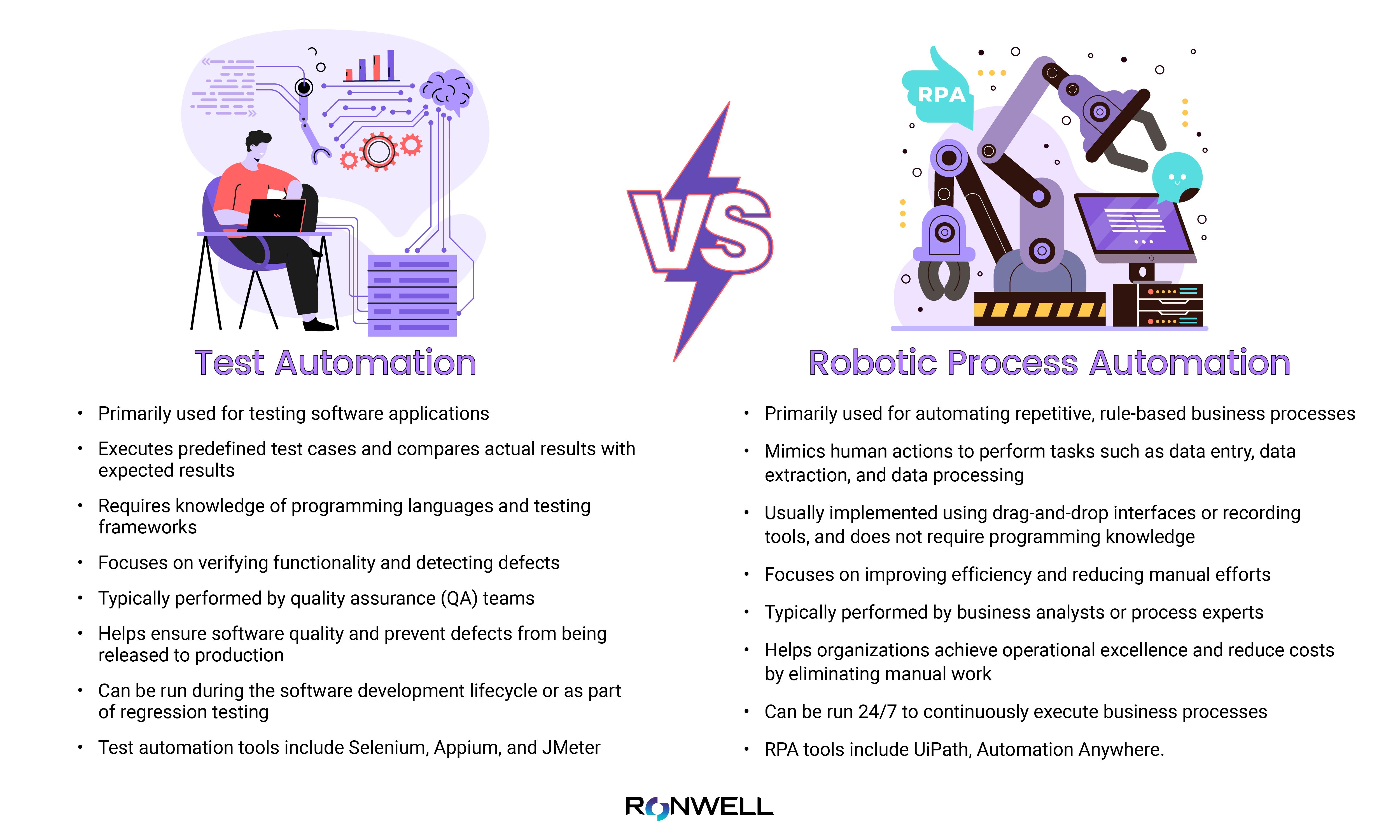

Our Services
Test Automation ServicesAI & Machine LearningBlockchainCRM ConsultingData Science & EngineeringDevOpsDigital MarketingDigital TransformationEmbedded Software DevelopmentERP Consulting ServicesManaged IT ServicesMergers & Acquisitions AdvisoryQA And Testing ServicesRobotic Process Automation SAP Consulting DevelopmentSoftware and Application DevelopmentSQL ConsultingStrategy ConsultingSustainability
- Contact Us
Our Services
- Test Automation Services
- AI & Machine Learning
- Blockchain
- CRM Consulting
- Data Science & Engineering
- DevOps
- Digital Marketing
- Digital Transformation
- Embedded Software Development
- ERP Consulting Services
- Managed IT Services
- Mergers & Acquisitions Advisory
- QA And Testing Services
- Robotic Process Automation
- SAP Consulting Development
- Software and Application Development
- SQL Consulting
- Strategy Consulting
- Sustainability
Insight
Company
Industries
- Contact Us

RPA vs Test Automation: What’s the differences?
Confused about RPA with test automation? Let’s explore similarities and differences between Test Automation vs. Robotic Process Automation.
- insight
- /
- blog
- /
- rpa-vs-test-automation
In today's fast-paced world, businesses are always looking for ways to optimize their operations to remain competitive. Automation is a popular solution that many business leaders consider to reduce costs, increase productivity and accuracy, and free up their employees from tedious and repetitive tasks. One of the most recent automation techniques that have gained a lot of momentum is Robotic Process Automation.
RPA involves automating repetitive and rule-based tasks using software robots or bots. These bots can quickly and accurately perform tasks that were previously done by humans, such as data entry, data extraction, and report generation. By implementing RPA, businesses can save time and resources, and their employees can focus on more critical tasks that require human intervention.
However, some people may confuse RPA with test automation. Although both involve automation, they have different goals and approaches. Test automation focuses on automating the testing process to ensure that software applications meet the required quality standards. RPA, on the other hand, aims to automate specific business processes to improve efficiency and productivity.
In this article, we will delve deeper into these two critical automation methods: RPA and test automation. We will explore their similarities and differences between two and you will have a better understanding of these two automation methods and how they can help businesses optimize their operations.
As Ronwell, we offer both test automation and robotic process automation services.
Let’s get started with the meaning of robotic process automation.

What is Robotic Process Automation (RPA)?
Robotic process automation, commonly known as RPA, is a method of automating business processes using virtual robots or AI. Unlike traditional workflow automation methods that require software engineers to write code that communicates with a system through its API to automate tasks, RPA eliminates the need for human intervention.
Instead, the RPA system watches a user perform tasks on an app's graphical interface and creates a list of actions that can be automatically repeated. RPA is gaining more attention in the business world because it offers a faster and more efficient way to automate repetitive and time-consuming assignments.
RPA bots use the keyboard and mouse like a human, but they work in a virtual environment without the need for a screen. This means that the bots operate like human assistants, but without the need for space or resources, as they can be programmed to work on several tasks simultaneously. The virtual nature of RPA makes it easier for businesses to scale their operations and allows them to complete more tasks in less time.
The primary goals of robotic process automation are to save cost, time, and allow employees to focus on other tasks that require more skill and attention. RPA has proven to be an excellent tool for achieving these objectives, as it frees employees from repetitive and time-consuming tasks. This allows them to focus on tasks that require critical thinking and decision-making skills, which can help improve overall productivity and efficiency.
However, it is important to note that RPA can cause bottlenecks and problems if not implemented properly. For instance, if the bots are not trained correctly or if the system is not well designed, the RPA implementation can cause more harm than good. Therefore, it is essential for businesses to work with experts in the field to ensure that they implement RPA correctly and avoid any negative consequences.
At Ronwell Digital, we are committed to helping our clients leverage the power of RPA to stay ahead in the competitive business landscape. Contact us now!
What is Test Automation?
Test automation is an essential part of software development that provides quick feedback on the quality of the software. The QA team mainly uses it for Regression testing. Tools such as Selenium webdriver are used to test web application functionality through a browser interface during the development phase. Test automation is widely used in Agile software development to increase team velocity.
Read our blog post about Top Automation Testing Tools.
Also, if you want to examine in detail what test automation is!
Unit testing, Integration testing (API testing), and Graphical user interface testing are the three main approaches to test automation, each requiring separate tools.
To receive quick feedback, automated test scripts should be executed as frequently as possible, ideally after every code change that is pushed to the repository.
Test automation provides various benefits, including saving time and costs, improving test coverage, reducing manual actions, improving accuracy compared to manual tests, and shortening time-to-market.
Read Also: Test Automation Strategy.
Looking for a reliable partner to help you with test automation? Ronwell Digital's Testing Service is the answer! By working with us, you can ensure the quality of your software while saving time and costs.
What is the Difference Between Test Automation and Robotic Process Automation?
Test Automation | Robotic Process Automation |
Primarily used for testing software applications | Primarily used for automating repetitive, rule-based business processes |
Executes predefined test cases and compares actual results with expected results | Mimics human actions to perform tasks such as data entry, data extraction, and data processing |
Requires knowledge of programming languages and testing frameworks | Usually implemented using drag-and-drop interfaces or recording tools, and does not require programming knowledge |
Focuses on verifying functionality and detecting defects | Focuses on improving efficiency and reducing manual efforts |
Typically performed by quality assurance (QA) teams | Typically performed by business analysts or process experts |
Helps ensure software quality and prevent defects from being released to production | Helps organizations achieve operational excellence and reduce costs by eliminating manual work |
Can be run during the software development lifecycle or as part of regression testing | Can be run 24/7 to continuously execute business processes |
Test automation tools include Selenium, Appium, and JMeter | RPA tools include UiPath, Automation Anywhere. |
FAQs
Is RPA a test automation?
No, RPA is not specifically designed for test automation, but it can be used for automating certain types of tests. While it can be used to automate end-to-end testing, it is not a replacement for traditional test automation tools.
Can test automation be used for RPA?
The short answer is YES. Test automation can be used for RPA development and deployment. It helps ensure that RPA bots function correctly and meet performance standards. Automated tests validate input and output of RPA bots, ensuring accurate and efficient task completion. Test automation also identifies potential issues and bottlenecks in RPA processes, allowing quick resolution. It is an essential tool for RPA development and deployment, ensuring RPA bots deliver expected results.
Can RPA be used for test automation?
Yes, RPA can be used for test automation. RPA bots can be programmed to perform repetitive and time-consuming testing tasks, such as regression testing, freeing up human testers to focus on more complex tests. RPA can also be used to automate end-to-end testing, ensuring that all systems and applications are working together as expected. Overall, RPA is a useful tool for test automation and can help improve efficiency and accuracy in testing processes.
Is Robotic Process Automation similar to Traditional Test Automation?
No, Robotic Process Automation and Traditional Test Automation are not similar. RPA tools are used to automate business processes, while traditional test automation tools are used to validate whether an IT application is performing as expected.
References
Daffodil - RPA Testing vs Test Automation
Sdc Automation - The Difference Between Robotic Process Automation and Test Automation
Writer:

Halime Yılmaz
Content Marketing Specialist
5 min read
3 March 2023, Friday
Related Posts
Related Industries






